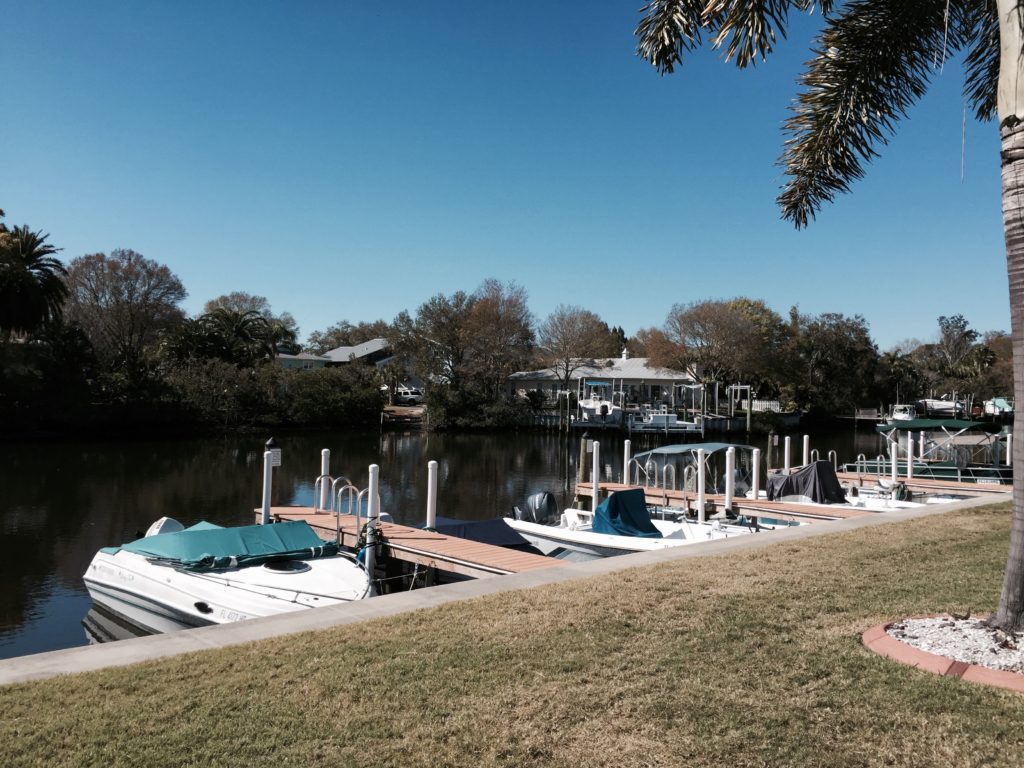Home Ownership Re-Imagined, Part 2:
Palmetto, Florida. Judy Smith slides her white convertible into a parking spot. She greets me at the door to the Country Lakes Co-Op, Inc., a resident-owned manufactured home community. The clubhouse overlooks a sylvan lake. And many of the houses sport embroidered flags, waving in the breeze. Golf carts abound. Traffic is far away.
Finding a resident-owned community
I’ve come here because the Country Lakes website has an excellent discussion of the economics of ownership versus land leasing. While investor-owned land lease communities are familiar to many, resident-owned communities are less well known. Some 55+-community websites are cute and folksy. Some are pretty. But the Country Lakes website explains the deal very nicely.
Judy Smith is enthusiastic. She lives here. She also sells the manufactured homes that are on leased land, leaving those with land ownership shares to licensed real estate agents. The least expensive unit here is offered for $12,000, without a co-op share. Another is pictured with 1,000 square feet, two bedrooms and two baths. Price: $29,500. Most are in a range of $20,000 to $35,000.
The lowest offering price for a home that includes land ownership thru a co-op share is $55,000.
The difference in dollars
What’s the difference? According to the website, when all expenses are compared, a leaseholder will pay about $7,200 a year to live in Country Lakes. A shareholder will pay about $4,100. The difference is $3,100 a year.
Figuring out the return on investment for the shares is tricky because homes and shares are sold together. But even if you accept the published current share price of $49,500, it’s 6.3 percent a year. If the price difference between comparable units, one with shares and one without, is about $30,000, the actual return on shares is about 10 percent. That return is also tax-free since ownership represents lower spending, not taxable cash income.
Even so, at Country Lakes, the house-only listings far outnumber the listings for houses with a co-op share included. Ms. Smith wishes more people were aware that as many as 30 percent of units in a resident-owned community can be on leased-land, just like the more common investor-owned RV and manufactured home parks.
A visit to Westwind
In Dunedin, just west of Tampa, I visit with Dan Hintz. He lives in the Westwind resident-owned community and is dually licensed to sell both manufactured homes without land and manufactured homes with shares.
Mr. Hintz, a young and outgoing 69, is a former small-town sheriff from Wisconsin. (His autobiographical book about it will soon be available on Amazon.com.) Like Judy Smith, he lives in the park where he sells. He also has an office in the park. While I was visiting, a steady stream of visitors came to ask questions.
Country Lakes and Westwind, with 471 and 380 homes, respectively, are larger and more typical than the 107 homes in the Crystal Bay community I reported on last week. But all three have an abundance of snowbirds, including some from Canada. All three are quiet places during the summer months. And all three have a community spirit that is hard to find in typical suburban home developments
Mr. Hintz hands me a sheet of current listings, a mixture of land-lease homes with a monthly lot rent of $520 and homes with shares that have a monthly maintenance fee of $120 to $150 a month. Units on leased land are offered for as little as $13,900 but most units are offered in the mid-twenties. The lowest-cost home that includes a share is offered at $56,900. It has nearly 1,000 square feet, two bedrooms and two baths. Most of the homes with shares are offered between $60,000 and the low seventies. But it is also possible to pay more: the most expensive home has an offering price of $112,000.
Will it sell for $112,000? Maybe. Maybe not.
But think about it. Compare one of these houses to a two-bedroom, two-bath condo. It is less expensive to buy. It is less expensive to operate. It has light from four sides. The walk with groceries from car to kitchen is short. You don’t have to take an elevator to get to your car. And even if the house itself depreciates, there is a good chance the land under it will appreciate.
And don’t forget, someone else mows the lawn.
Sidebar: Learn More On These Websites
There is a more detailed explanation of the differences between leased-land parks and resident owned parks on the Country Lakes Co-Op website: http://www.countrylakesco-op.com/Files/What_does_it_Cost_to_live_in_CLV.pdf and you can access the home page here: http://www.countrylakesco-op.com/index.html
This website provides both virtual tour videos and floor plans for typical modern manufactured homes: http://www.citrus-meadowood.com/model_center.html
The MH Village website lets you explore manufactured homes for sale throughout the United States, on leased-land and resident owned: https://www.mhvillage.com
Only two percent of all manufactured homes are in resident-owned communities. You can learn more about them on the Resident Owned Communities website: http://www.rocusa.org/for-homeowners/faqs.aspx
————————————————–
This information is distributed for education purposes, and it is not to be construed as an offer, solicitation, recommendation, or endorsement of any particular security, product, or service.
Photo: Scott Burns— boat slips at a resident-owned manufactured home community in Dunedin, FL
(c) A. M. Universal, 2015
